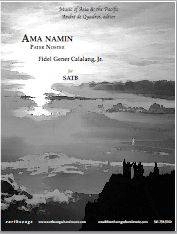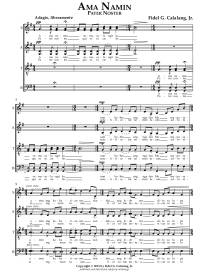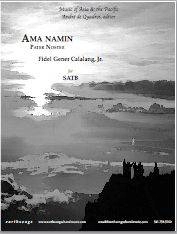Opens in a new window
Earthsongs Ama Namin (Pater Noster) - Calalang - SATB

Additional Photos:
This product is no longer available.
Great Additions
Description
- Composer/Author: CALALANG, FIDEL
- Instrumentation: SATB A CAP
- Model # S-410
Composer: Fidel Calalang
Language: Tagalog, Latin
Country: Philippines
Format: Choral Octavo
Voicing: SATB a cappella
Program Notes
Pater Noster is a Latin prayer known to many Christians in its English translation: the Lord's Prayer. The prayer has Biblical origins, and is found in the New Testament in the book of Luke, when Christ teaches his disciples to pray. In the Middle Ages, it became known as the Pater Noster because it was almost always recited in Latin, even by the uneducated. It is still recited and sung in many contexts, including Catholic Masses.
This setting of Pater Noster was originally written in the Tagalog language as Ama Namin (Our Father). The piece won first prize in an international choral composition competition in 1999 and was later transcribed to Latin by Dr. Joel Navarro. It is set for eight voices, depicting men and women in quiet prayerful worship in the opening antiphony. Humanity then embraces the prayer with more expressive fervor and adoration in the harmonic complexity of the middle section that escalates to a soaring end. A spirit of quiet joy and hope is revealed as the prayer closes with fading meditative passages and a short antiphonal conclusion.
Language: Tagalog, Latin
Country: Philippines
Format: Choral Octavo
Voicing: SATB a cappella
Program Notes
Pater Noster is a Latin prayer known to many Christians in its English translation: the Lord's Prayer. The prayer has Biblical origins, and is found in the New Testament in the book of Luke, when Christ teaches his disciples to pray. In the Middle Ages, it became known as the Pater Noster because it was almost always recited in Latin, even by the uneducated. It is still recited and sung in many contexts, including Catholic Masses.
This setting of Pater Noster was originally written in the Tagalog language as Ama Namin (Our Father). The piece won first prize in an international choral composition competition in 1999 and was later transcribed to Latin by Dr. Joel Navarro. It is set for eight voices, depicting men and women in quiet prayerful worship in the opening antiphony. Humanity then embraces the prayer with more expressive fervor and adoration in the harmonic complexity of the middle section that escalates to a soaring end. A spirit of quiet joy and hope is revealed as the prayer closes with fading meditative passages and a short antiphonal conclusion.
Media
Sound Sample
Press play to listen
Q & A
There are currently no questions for this product.
Reviews
There are currently no reviews for this product. Be the first to write one!




